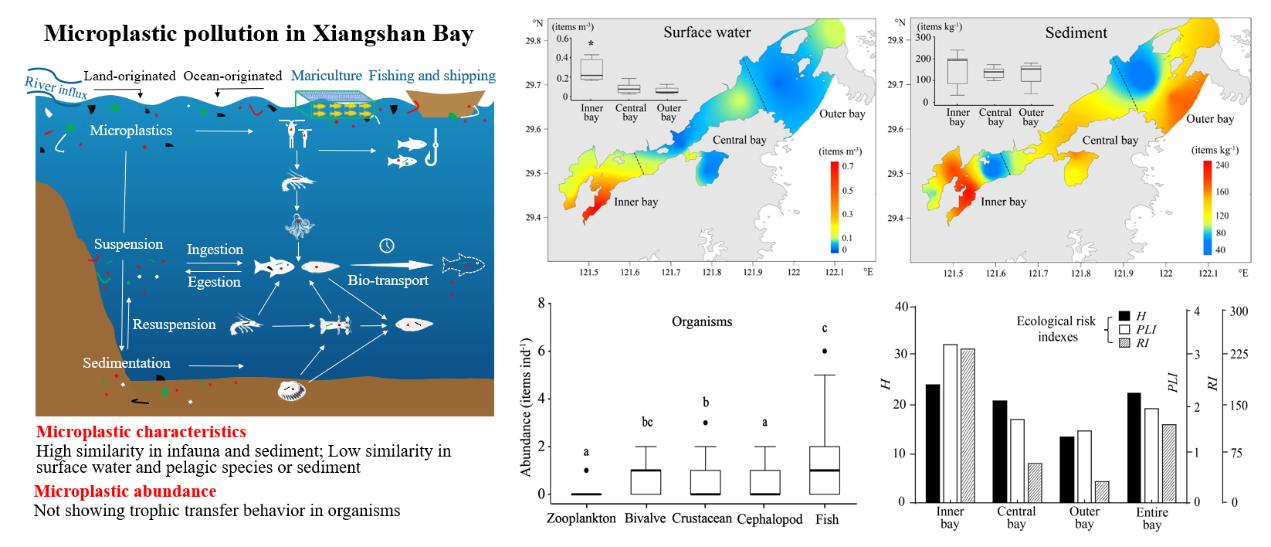Scientists Reveal Mystery of Microplastic Pollution in Xiangshan Bay, East China Sea
Microplastic (< 5 mm) pollution in oceans is an emerging environmental problem that poses ecological risks for marine ecosystems. Previous studies have provided knowledge and enhanced our understanding of the abundance, distribution, characteristics, and sources of microplastics in the global oceans.
However, some general topics on the mechanisms underlying the transfer and behavior of microplastics in different media, as well as their ecological risks, are not adequately addressed or understood.
Recently, the research team led by Prof. DOU Shuozeng from the Institute of Oceanology, Chinese Academy of Sciences (IOCAS), found new insight into coastal microplastic pollution, source tracing, and ecological risk.
The study was published in Water Research.
In the water, microplastics were most abundant in the inner bay, in the region concentrated with intensive mariculture operations. Mariculture-originated plastics were a major contributor to the microplastics in this region.
The low hydrodynamics in the inner bay favored microplastic retention. The inner bay was almost entirely enclosed by land with low hydrodynamics. There was a disruption of microplastics diffusion or transportation from the inner bay to other waters, facilitating the retention or accumulation of microplastics.
In the sediment, the spatial distribution of microplastics did not significantly differ across the bay. Overall, the characteristics of the microplastics in the two environmental media were heterogeneous in terms of shape and chemical components. The ecological risks from microplastics in the water of the bay were at a low-moderate level, these were much higher in the inner bay than in the other parts of the bay.
Microplastic abundance ingested by organisms were related to their biological features and foraging habits. Overall, fish ingested more microplastics than crustaceans, bivalves, and cephalopods, while zooplankton ingested minimal microplastics.
Filter feeders (e.g., zooplanktons, crustaceans, and bivalves) ingested fewer microplastics and showed a preference for smaller particles than predatory species such as some species of fish. microplastics did not show trophic transfer behavior in the organisms.
This study demonstrated that microplastics in the marine environmental media or organisms do not necessarily show high similarity in abundance or morphological and chemical characteristics.
"Microplastics in all tissues of organisms should be included when trophic transfer of microplastics is proposed or addressed. The toxicity of other contaminants attached to microplastics should be considered at ecological risk assessment for microplastics," said Prof. DOU.
This study contributes to a more comprehensive understanding of microplastic pollution, source tracing, trophic transfer, and ecological risk in coastal ecosystems.
This work was supported by the Zhejiang Provincial Natural Science Founds for Distinguished Young Scientists, National Natural Science Foundation of China, and State Key Laboratory of Satellite Ocean Environment Dynamics.

Microplastic pollution in Xianshang Bay, East China Sea
Xiang Yu, Wei Huang*, Youji Wang, Yuntao Wang, Liang Cao, Zhi Yang, Shuozeng Dou*. Microplastic pollution in the environment and organisms of Xiangshan Bay, East China Sea: an area of intensive mariculture. Water Research, 2022, 212: 118117.
DOU Shuozeng
Institute of Oceanology
E-mail: szdou@qdio.ac.cn
(Editor: ZHANG Yiyi)